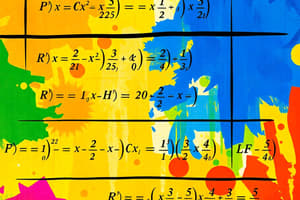Podcast
Questions and Answers
What does the derivative of a function represent?
What does the derivative of a function represent?
- The rate of change or slope at a specific point (correct)
- The maximum value of the function
- The total area under the function's curve
- The derivative of the second function
Which of the following is the correct representation of the Power Rule for derivatives?
Which of the following is the correct representation of the Power Rule for derivatives?
- $ rac{d}{dx}(x^n) = nx^{n+1}$
- $ rac{d}{dx}(x^n) = nx^{n-2}$
- $ rac{d}{dx}(x^n) = n^2x^{n-1}$
- $ rac{d}{dx}(x^n) = nx^{n-1}$ (correct)
In the context of the Chain Rule, what does $
rac{d}{dx}(f(g(x)))$ equal?
In the context of the Chain Rule, what does $ rac{d}{dx}(f(g(x)))$ equal?
- $f(g(x)) imes g'(x)$
- $f(g'(x)) imes g'(x)$
- $f'(g(x)) imes g'(x)$ (correct)
- $f'(x) imes g(x)$
What does the second derivative, denoted as $f''(x)$, indicate about a function?
What does the second derivative, denoted as $f''(x)$, indicate about a function?
Which rule would you use to differentiate the product of two functions, $u$ and $v$?
Which rule would you use to differentiate the product of two functions, $u$ and $v$?
Flashcards are hidden until you start studying
Study Notes
Definition
- A derivative measures how a function changes as its input changes.
- It represents the rate of change or the slope of the function at a particular point.
Notation
- Common notations for derivatives include:
- ( f'(x) ) or ( \frac{df}{dx} ) for a function ( f ).
- ( Df ) for the derivative operator.
Basic Concepts
- Instantaneous Rate of Change: The derivative gives the slope of the tangent line to the curve of the function at a specific point.
- Tangent Line: The line that touches the function at a point without crossing it.
Rules of Differentiation
- Power Rule:
- ( \frac{d}{dx}(x^n) = nx^{n-1} )
- Product Rule:
- ( \frac{d}{dx}(uv) = u'v + uv' )
- Quotient Rule:
- ( \frac{d}{dx}\left(\frac{u}{v}\right) = \frac{u'v - uv'}{v^2} )
- Chain Rule:
- ( \frac{d}{dx}(f(g(x))) = f'(g(x)) \cdot g'(x) )
Higher-Order Derivatives
- The second derivative ( f''(x) ) is the derivative of the derivative, indicating the curvature of the function.
- Higher-order derivatives can be denoted as ( f^{(n)}(x) ).
Applications
- Finding Slopes: Determine the slope of curves at points.
- Optimization: Identify maximum and minimum values of functions using critical points.
- Motion: Derivatives represent velocity and acceleration in physics.
Special Functions
- Exponential Functions:
- ( \frac{d}{dx}(e^x) = e^x )
- Trigonometric Functions:
- ( \frac{d}{dx}(\sin x) = \cos x )
- ( \frac{d}{dx}(\cos x) = -\sin x )
Implicit Differentiation
- Used when functions are defined implicitly rather than explicitly.
- Differentiate both sides of the equation with respect to ( x ) and solve for ( \frac{dy}{dx} ).
Summary
- Derivatives are foundational concepts in calculus that describe how functions behave.
- Mastery of differentiation rules and applications is essential for solving practical problems in mathematics and sciences.
Definition
- A derivative quantifies the change in a function's output in response to changes in its input.
- It signifies the rate of change or slope at specific points on a graph.
Notation
- Common derivative notations include:
- ( f'(x) ) or ( \frac{df}{dx} ) to represent the derivative of a function ( f ).
- ( Df ) for indicating the differentiation operator.
Basic Concepts
- Instantaneous Rate of Change: The derivative indicates the slope of the tangent line at any point on a function's curve.
- Tangent Line: A straight line that touches the function at one point without intersecting it.
Rules of Differentiation
- Power Rule:
- The derivative of ( x^n ) is calculated as ( nx^{n-1} ).
- Product Rule:
- For the product of two functions ( u ) and ( v ), the derivative is ( u'v + uv' ).
- Quotient Rule:
- For the quotient of two functions ( u ) and ( v ), the derivative is ( \frac{u'v - uv'}{v^2} ).
- Chain Rule:
- For composite functions, the derivative is given by ( f'(g(x)) \cdot g'(x) ).
Higher-Order Derivatives
- The second derivative, denoted as ( f''(x) ), measures the curvature of the function.
- Higher-order derivatives are expressed as ( f^{(n)}(x) ) for ( n )th derivatives.
Applications
- Finding Slopes: Derivatives help pinpoint the slope at specific points along curves.
- Optimization: Critical points identified through derivatives help find function maxima and minima.
- Motion: Derivatives represent physical concepts like velocity and acceleration.
Special Functions
- Exponential Functions: The derivative of ( e^x ) remains ( e^x ).
- Trigonometric Functions:
- ( \frac{d}{dx}(\sin x) ) yields ( \cos x ).
- ( \frac{d}{dx}(\cos x) ) results in ( -\sin x ).
Implicit Differentiation
- This technique allows differentiation when functions are defined in an implicit manner.
- To find ( \frac{dy}{dx} ), differentiate both sides of the equation with respect to ( x ) and solve accordingly.
Summary
- Derivatives are central to calculus, offering insights into function behavior.
- Proficiency in differentiation rules and real-world applications is critical for problem-solving across various mathematical and scientific domains.
Studying That Suits You
Use AI to generate personalized quizzes and flashcards to suit your learning preferences.




